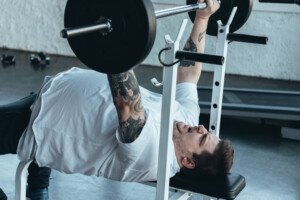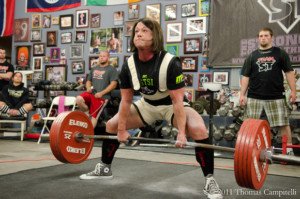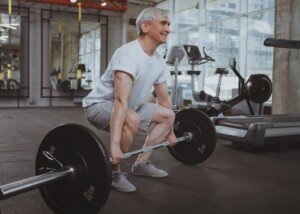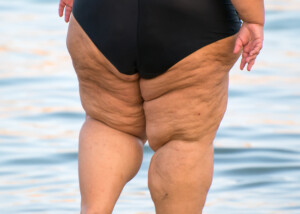
Here’s a reason why it seems that the fat people at a gym can lift heavier weights than the thinner people.
I was inspired to write this article after reading a question in a fitness forum that read something like, “Why do fat people lift more weight than skinny people?”
The answers were interesting, but nobody nailed what’s really going on here.
I’m a former certified personal trainer and have some answers.
It’s too general to outright state: “Fat people can lift more weight than skinny folks.”
To put it this generally implies that heavy individuals have much more overall physical strength than do lean people. This simply is not true.
First of all, the type of lift has to be considered.
Based on my experience as a personal trainer, very overweight individuals tend to lift more weight than skinny people, when they are matched for other variables such as experience in strength training, gender and age range:
- Leg press
- Lat pull-down
- Seated row
- Seated chest press
Other personal trainers may think the bench press belongs on the list, but if a person is overweight enough, the excess girth in their midsection will reduce the range of motion of the pressing movement.
This will allow them to handle more weight (the bar won’t come down as far because their large girth will get in the way).

Shutterstock/LightField Studios
I’ve also seen overweight women bench pressing the same amount of weight as thinner women — fatiguing at the same rate.
When a person is fat, their body is forced to work against this extra resistance just in the activities of daily living.
If someone is 100 pounds overweight, think of what the bones and muscles/tendons of their legs must put up with day in and day out.

All that extra poundage forces their legs to become more efficient at handling resistance.
Exceptions are the so-called “Walmart fat” people who appear to struggle with basic ambulation.
They are usually not much stronger than their smaller sedentary counterparts.
But for more active obese people, particularly younger, there is a carryover to the leg press movement.
The same principle applies to the lat pull-down, seated row and seated chest press.
So why doesn’t it apply to the barbell squat and deadlift?
Laura Phelps Sweatt is one of the strongest powerlifters around, yet has a low body fat percentage.

Laura Phelps Sweatt: Insanely strong, anything but fat.
Standing 5-5, she has competed in the 165 pound weight class as well as 181 pound.
But check out photos of her and see if you can find any excess fat on her body.
Many male and female competitive powerlifters with ridiculously heavy lifts to their credit are not fat.
Though the heaviest power lifts are never performed by “skinny” athletes, they aren’t what you’d call “fat,” either.
When Laura Phelps Sweatt weighs in at 181 pounds, she hardly looks like the average 5-5, 180 pound woman off the street. Nothing near it.
The strongest male powerlifters DO seem to have a noticeable amount of excess bodyfat, but keep in mind that in order to develop their strength (train like demons and grow super strong muscle fibers), they must EAT.
Unlike bodybuilders, they’re not concerned about their appearance.
To gain extraordinary strength they must ingest a caloric surplus.
But let’s get back to ordinary people working out in a gym.
Fat people struggle with many moves, but this doesn’t mean they can’t train hard, lose some fat in the process and become very good at powerlifting.
Some fat man or woman will struggle with the squat and deadlift because these are done while standing and require particular form.
Often, an obese man or woman has issues with their low back, which is another reason the deadlift and squat can be troublesome when attempting a heavy weight.
The farmer’s walk is no picnic, either. Hamstring curls and leg extensions are comparable to what skinny (but not malnourished) people can do, and in fact, fat trainees are more likely to have problems with their knees.
I recall two husky 20-something men I had as clients; both could barely press 15 pound dumbbells in each hand overhead for 15 reps.
Obese individuals do no better than thin or straight-size people when it comes to weightlifting moves such as lateral raises, frontal raises and triceps push-downs.
Barbell and dumbbell curls don’t stand out much either.
If you notice that the strongest people in the gym are fat, take a closer look.
The strongest people may be big, but that doesn’t mean Walmart fat, though that isn’t to say they can’t stand to lose some pounds in their guts.
Perhaps you’ve heard that “mass moves mass,” but at the same time, there are a LOT of obese and morbidly obese people out there who struggle just to carry the garbage to the trash bin, or carry a child to the car and then put the child in a carseat.
Another possibility is that an overweight person may passionately take up strength building simply because it puts them on an even playing field with thin people.
It offsets any despair they may have with their performance on a treadmill, on a hike, in a step aerobics class or a yoga class.
They’re under no perceived pressure to lose pounds if they take up weightlifting.
Their commitment pays off in the form of impressive lifting.
A very large lower body can also act as a more solid base of support for Olympic style lifts as well as the deadlift and back squat.









































